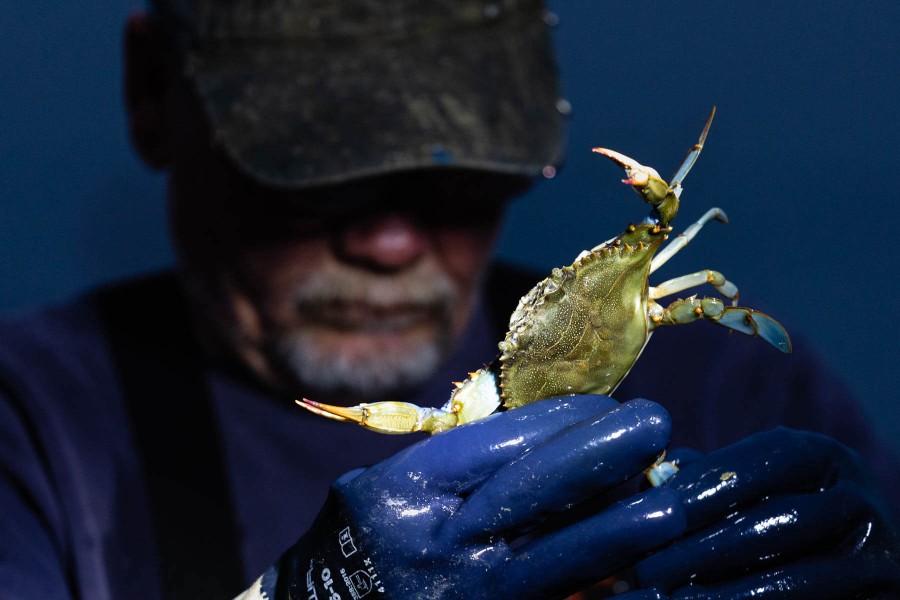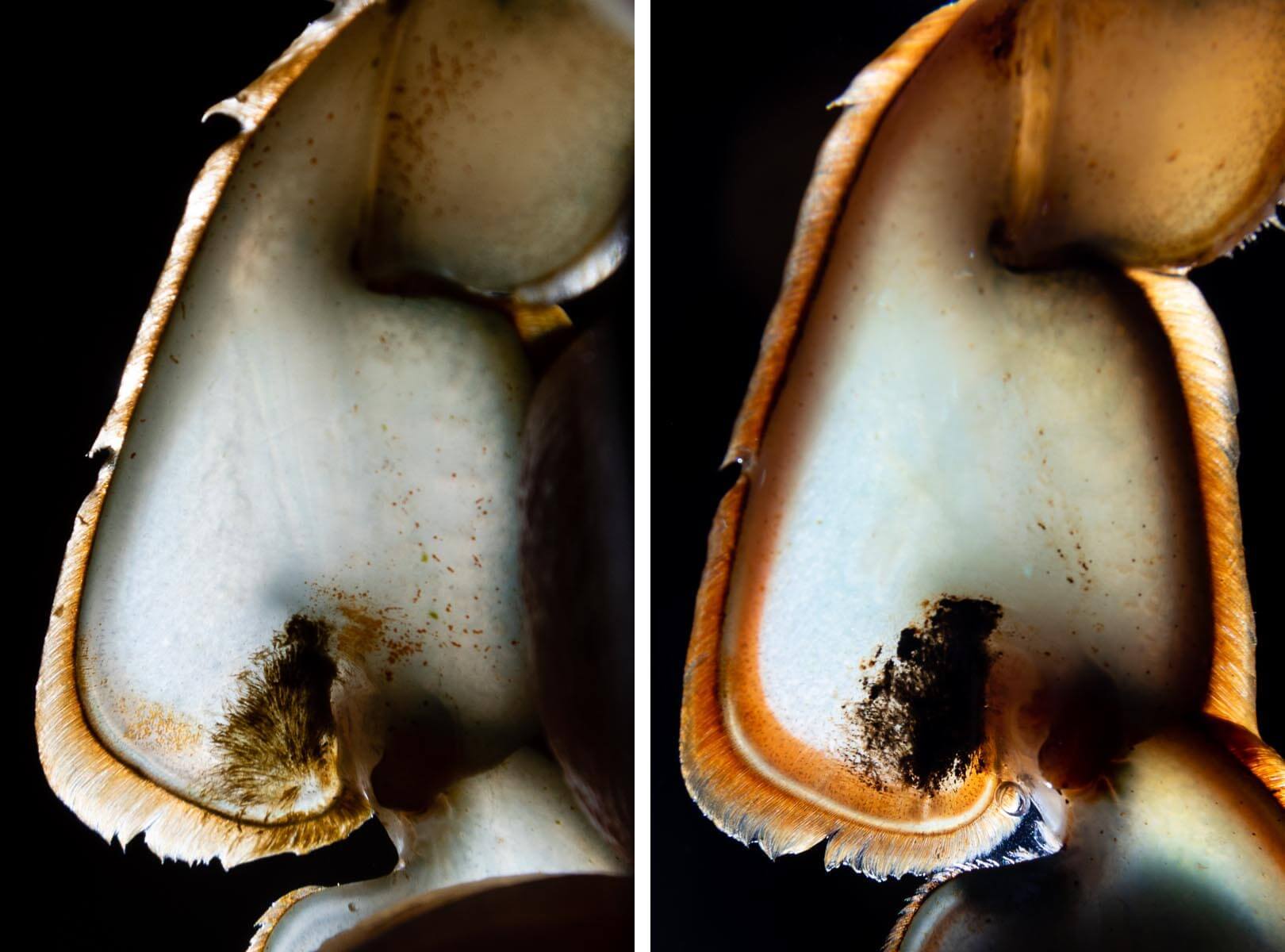Clues of a growing blue crab

Imagine looking into the water and seeing a crab. Can you tell if its male or female? Young or old? Hard or soft? Probably not with any accuracy as it swims by, but some Bay experts have the ability to determine exactly what stage of crab they’re seeing and the precise day it will shed its old shell, just by looking into the water.
“I can tell—I’m at the point now I’ve done this for so many years, I can just look at them in the water and know where they’re at,” says Butch Walters, a Chesapeake watermen. “They swim different.”
Butch Walters and his first mate Steve Lee are watermen, skilled fishers who have been crabbing and oystering the Chesapeake Bay most of their lives and possess intimate knowledge of the water and its creatures. Watermen must walk the line between a robust harvest now and a healthy population for the future, so being able to quickly determine the blue crab’s precise molting stage helps soft-crabbing watermen avoid catching premature crabs or missing them once they’ve grown.
On a boating trip in the waters of the Tangier Sound, Walters and Lee shared their knowledge and some insider tips on recognizing the signs of growing blue crabs about to replace their old shells. With their expertise and a bit of the background science, you too can try your hand at picking out clues of blue crab changes.
Why do blue crabs shed their shells?
Callinectes sapidus, the beautiful, savory swimmer, is the iconic Chesapeake creature featured on menus throughout the year as a “hard crab” and a “soft crab.” Far from being different animals, hard crabs and soft crabs are just different stages in the growing cycle of a blue crab shedding its shell. While this process is often referred to as “molting,” which is what birds go through, or “shedding,” like what dogs do, the proper term for crabs discarding their shells is “ecdysis” (pronounced ˈek-de-ses’).
The hard shell of a blue crab stays the same size, but the tissue of the crab itself is always growing. Small crabs will shed four or five times a month, while older crabs may take thirty to fifty days to grow large enough before needing to shed again.
A newly shed crab will be about a third bigger than it was before. As you can imagine, that’s a lot of new crab to be cramped and squished into a small shell. As the crab outgrows its old, small shell and needs to break free, it uses several strategies—and a little help from the water—to make it happen.

The first signs of a growing crab
Like most drastic changes, everything starts with hormones. Hormones trigger the crab to begin detaching its body from the shell. As this is happening, the hypodermis—a layer of cells directly under the hard shell—creates enzymes that begin to dissolve and thin the old shell. As the old shell dissolves and thins, the crab saves energy by storing dissolved components of the old shell to help harden the future shell.
Look to the back fin on the crab, right above the segment of the leg that looks like a little paddle. This blueish area begins to grow paler and a very thin, barely visible white line begins to appear. Called the “white sign,” this mark is the edge of the barely-beginning-to-form new shell that you are seeing through the old one.
Reportedly, this stage is reversible if conditions are not just right. “A white sign crab,” says Walters, “he can go back to a hard crab if it’s too cold.” Blue crabs typically begin their shedding cycles around mid April and continue until cold weather moves in in late fall.
Watching and waiting
First mate Lee, like most watermen, is practiced at quickly identifying soft crabs on a moving boat. He can hold a crab up to the sun to help highlight the white sign (appearing about 10 to 14 days prior to molting) before sorting the crab properly. This sign can be difficult for laymen to discern even when up close and stationary. The next sign, which becomes apparent about 5 or 6 days before a hard crab turns to a soft crab, is a bit more visible.
The white sign in the backfin continues to sharpen and darken as the new shell continues forming beneath the old over the next several days. White becomes pink about 5 days out, followed by red with just a day or two to go. “Rank” crabs have a deep red line and are mere hours from shedding.
Non-watermen can see the difference between whitish pink and rank red, but the experts have the color hues down to a science. Out on the water, Lee looks at a crab through the eyeglasses he wears affixed to the brim of his ballcap. “He’ll be a tomorrow morning, not tonight” affirms Lee, casually tossing a crab he calls “deep pink” into the appropriate bucket.
Breaking out of the old shell
Once a crab is ready to break out, it needs a little help from the Bay. The crab takes in saltwater to puff itself up and expand its new body, which busts open the horizontal seam of its old shell across the widest part of the crab. Puffed up crabs bursting out of their shells in this way are called “busters.”
Taking about 2 hours to complete the process, the crab backs out of the old shell through the split, carefully pulling its legs and claws out last.
Crabs newly emerged from their shells, called “pat-softs,” are too soft to be sold as soft crabs. Their malleable new shells appear wrinkled, and they are vulnerable to the fast-swimming crabs that have already hardened their new shells. These newly hardened crabs, called “green” for their newness or “white” for their newly bright white abdomens, occasionally cannibalize the weak pat-softs. Pat-softs will reach the texture of culinary-ready soft crabs in about three to four hours.
Becoming a hard crab again
During the stage of hardening from a soft crab back to a hard crab, called post-ecdysis, the crab uses the dissolved shell components it has been holding to harden the larger, roomier new shell. The water it pulled into its body helps fill up the new spaces and holds shape while the shell hardens, a process that takes a day or two to fully complete. As the crab grows inside its new shell, the water will gradually be displaced by protein and tissue until the crab is ready to develop a larger shell once again.
Soft crabs need water in order to harden back up into blue hard crabs. Once out of the water, the shell is suspended at the current stage of hardening.
Ready for the dinner table
Soft crab season in the Chesapeake usually begins with a “first-run” in early May and continues through the fall, though this is largely dependent on weather and tides. It may also, so they say, depend on the moon; many crabbers will say they see a larger batch of soft crabs when the moon is full. Get to know your local watermen and seafood distributors to find the best times to get soft crabs in your area, or go by this maxim: as long as it is the legal season, the best time for soft crabs is whenever you can get them.

Comments
Great article! Really informative. Thank you.
Great article. I,m from Crisfield now living in Denver. Miss those Eastern Shore soft crab BTL sandwiches. Your article would be inter sting if you but some more waterman slag about soft crab. (ie. buster, rank, souck,difference between male and female )
Thank you!
Your comment has been received. Before it can be published, the comment will be reviewed by our team to ensure it adheres with our rules of engagement.
Back to recent stories